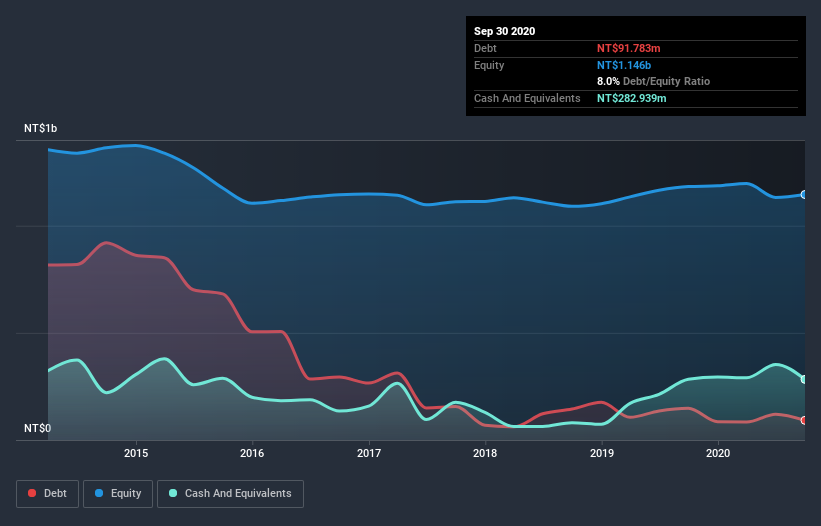The external fund manager backed by Berkshire Hathaway's Charlie Munger, Li Lu, makes no bones about it when he says 'The biggest investment risk is not the volatility of prices, but whether you will suffer a permanent loss of capital.' So it seems the smart money knows that debt - which is usually involved in bankruptcies - is a very important factor, when you assess how risky a company is. As with many other companies ThinTech Materials Technology Co., Ltd. (GTSM:3663) makes use of debt. But the more important question is: how much risk is that debt creating?
Why Does Debt Bring Risk?
Debt and other liabilities become risky for a business when it cannot easily fulfill those obligations, either with free cash flow or by raising capital at an attractive price. Part and parcel of capitalism is the process of 'creative destruction' where failed businesses are mercilessly liquidated by their bankers. However, a more frequent (but still costly) occurrence is where a company must issue shares at bargain-basement prices, permanently diluting shareholders, just to shore up its balance sheet. By replacing dilution, though, debt can be an extremely good tool for businesses that need capital to invest in growth at high rates of return. The first thing to do when considering how much debt a business uses is to look at its cash and debt together.
Check out our latest analysis for ThinTech Materials Technology
How Much Debt Does ThinTech Materials Technology Carry?
The image below, which you can click on for greater detail, shows that ThinTech Materials Technology had debt of NT$91.8m at the end of September 2020, a reduction from NT$147.9m over a year. But it also has NT$282.9m in cash to offset that, meaning it has NT$191.2m net cash.

How Healthy Is ThinTech Materials Technology's Balance Sheet?
Zooming in on the latest balance sheet data, we can see that ThinTech Materials Technology had liabilities of NT$391.3m due within 12 months and liabilities of NT$119.4m due beyond that. Offsetting these obligations, it had cash of NT$282.9m as well as receivables valued at NT$337.2m due within 12 months. So it can boast NT$109.5m more liquid assets than total liabilities.
This surplus suggests that ThinTech Materials Technology has a conservative balance sheet, and could probably eliminate its debt without much difficulty. Simply put, the fact that ThinTech Materials Technology has more cash than debt is arguably a good indication that it can manage its debt safely.
On top of that, ThinTech Materials Technology grew its EBIT by 72% over the last twelve months, and that growth will make it easier to handle its debt. The balance sheet is clearly the area to focus on when you are analysing debt. But you can't view debt in total isolation; since ThinTech Materials Technology will need earnings to service that debt. So when considering debt, it's definitely worth looking at the earnings trend. Click here for an interactive snapshot.
Finally, a business needs free cash flow to pay off debt; accounting profits just don't cut it. ThinTech Materials Technology may have net cash on the balance sheet, but it is still interesting to look at how well the business converts its earnings before interest and tax (EBIT) to free cash flow, because that will influence both its need for, and its capacity to manage debt. Over the last three years, ThinTech Materials Technology actually produced more free cash flow than EBIT. There's nothing better than incoming cash when it comes to staying in your lenders' good graces.
Summing up
While we empathize with investors who find debt concerning, you should keep in mind that ThinTech Materials Technology has net cash of NT$191.2m, as well as more liquid assets than liabilities. And it impressed us with free cash flow of NT$130m, being 288% of its EBIT. So is ThinTech Materials Technology's debt a risk? It doesn't seem so to us. When analysing debt levels, the balance sheet is the obvious place to start. However, not all investment risk resides within the balance sheet - far from it. For instance, we've identified 4 warning signs for ThinTech Materials Technology that you should be aware of.
When all is said and done, sometimes its easier to focus on companies that don't even need debt. Readers can access a list of growth stocks with zero net debt 100% free, right now.
If you decide to trade ThinTech Materials Technology, use the lowest-cost* platform that is rated #1 Overall by Barron’s, Interactive Brokers. Trade stocks, options, futures, forex, bonds and funds on 135 markets, all from a single integrated account. Promoted
Valuation is complex, but we're here to simplify it.
Discover if ThinTech Materials Technology might be undervalued or overvalued with our detailed analysis, featuring fair value estimates, potential risks, dividends, insider trades, and its financial condition.
Access Free AnalysisThis article by Simply Wall St is general in nature. It does not constitute a recommendation to buy or sell any stock, and does not take account of your objectives, or your financial situation. We aim to bring you long-term focused analysis driven by fundamental data. Note that our analysis may not factor in the latest price-sensitive company announcements or qualitative material. Simply Wall St has no position in any stocks mentioned.
*Interactive Brokers Rated Lowest Cost Broker by StockBrokers.com Annual Online Review 2020
Have feedback on this article? Concerned about the content? Get in touch with us directly. Alternatively, email editorial-team (at) simplywallst.com.
About TPEX:3663
ThinTech Materials Technology
Designs, manufactures, and sells alloys and optoelectronics materials in Taiwan and internationally.
Adequate balance sheet with low risk.
Market Insights
Community Narratives



